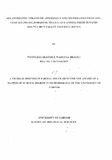| dc.contributor.author | Wabusya, Nyongesa B. | |
| dc.date.accessioned | 2013-07-02T15:33:07Z | |
| dc.date.available | 2013-07-02T15:33:07Z | |
| dc.date.issued | 2013 | |
| dc.identifier.citation | M.sc. | en |
| dc.identifier.uri | http://erepository.uonbi.ac.ke:8080/xmlui/handle/123456789/44295 | |
| dc.description | Master of Science Degree in Microbiology | en |
| dc.description.abstract | Aspergillus flavus are fungi found naturally in the soil and they are associated with aflatoxin
production which are of public health importance due to their effects on human health and
also threaten food security and safety. Aflatoxins are produced over a temperature range of
25- 30°C with an optimal water activity for growth 0.99 for A. flavus. Aflatoxins have been a
problem in Kenya especially in Eastern and Central Provinces resulting into aflatoxicosis.
However the Rift Valley which is the main region that producing maize in Kenya, with
suitable climate for the growth and proliferation of Aspergillus although there have been not
reported cases of aflatoxicosis. This study aimed at establishing the distribution of
aflatoxigenic strains of Aspergillus in soil, cereal grains and animal feeds in Nandi County,
Rift Valley Province of Kenya. A cross section research design was applied within the
County and purposive sarnpl ing used to deterrn il)f4 t)e number of households to be included
from the three sub locations, Kilibwoni, Laboret and Kapturno. Quota sampling was used to
determine the number of households from each sub location that gave a sample size of 255
qualifying households. Households were randomly selected Samples of soil,, cereals grains
and animal feeds, were collected from the 255 households together with the market samples.
Isolation of Aspergillus species from the soil samples was done using dilution plating
technique and the rest of the samples direct plating was used in the isolation. Aspergillus
section Flavi was identified using morphological keys. The ajlQ and ajlO genes were
amplified to identify toxigenic and non-toxigenic strains of A. flavus and A. parasiticus and
the isolates screened for aflatoxin production using LCMSMS. All the food samples were
analysed for aflatoxins using ELISA.
The results showed high incidence of Aspergillus section Flavi of both in maize (56.8%) and
soil (57.7%). This group of Aspergillus were of the L strain. Out of 78 isolates of Aflavus
55% were toxigenic and the rest non-toxigenic. Two of the plugs produced considerable hig
amounts of aflatoxins in vitro of 74367 }1g Ikg and 80664 ug/Kg when screened usrng
LCMSMS technique. The household cereal grains had average levels of below 5 ug/kg which
was less than set legal limit for aflatoxins in foodstuff and feeds of I0 ug/kg by the East
Africa Community/Kenya Bureaus of Standard. The low levels of aflatoxins in cereal grain
samples could be because of the low temperatures (25°C-30°C) in Nandi which did not
favour aflatoxin production. The study has revealed a high incidence (78%) of aflatoxigenic
species of A. flavus producing low levels of atlatoxins in household cereal grains and animal
feeds. This explains why there have been no cases of aflatoxicosis in Nandi arising from
consumption of maize grown by farmers in the region. The population had high exposure to
low levels of aflatoxins through consumption of the maize, other foods and milk from the
animals that have been fed on these feeds contaminated with aflatoxins. This chronic
exposure and the accompanying health implications should be investigated and further
studies should be carried out on field feasibility and strategies for developing biocontrol
methods against aflatoxin producing fungi in Kenya. | en |
| dc.language.iso | en | en |
| dc.subject | Aspergillusflavus | en |
| dc.subject | Aflatoxins | en |
| dc.subject | aflD and aflQ genes | en |
| dc.subject | Maize | en |
| dc.subject | Soil | en |
| dc.title | Aflatoxigenic strains of aspergillus species isolated from soil, cereals (maize, sorghum, millet) and animal feeds in Nandi County rift valley province, Kenya | en |
| dc.type | Thesis | en |
| local.publisher | School of Biological Sciences, University of Nairobi | en |

